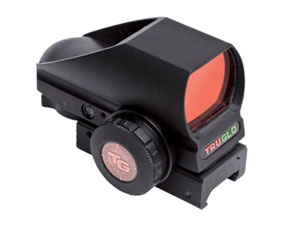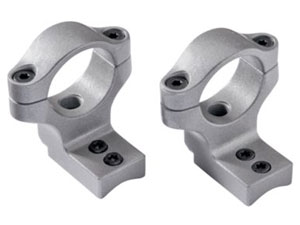
So you've just picked up a fancy new rifle and you need a new scope to go with it. Or maybe your eyesight isn't what it used to be and you've decided that it might be time to finally put some glass on top of your old shooting iron. But there are so many different models and styles of scopes available today. Which one's right for you? Here's what you need to know.
 |
| The size and power of the scope you ultimately choose will depend on your firearm and the hunting you do. |
The first thing to understand is how a scope works, and herein lays one of the major advantages of a scope over iron sights. A scope is a metal (usually aluminum) tube, encasing a series of coated glass lenses which allow the target to be viewed on the same focal plane as the sights. This means that rather than trying to keep the rear sight, the front sight and the target all in focus at the same time (impossible for the human eye), everything is in focus together, along with a nicely-positioned sighting reference in the form of crosshairs or some other type of reticle. Add target magnification to the mix, and you have an almost-perfect sighting system.
In order to make an informed choice, however, you also need to understand some of the terms used in the optics industry and what they mean for you.
Specifications
The specifications of a typical scope are usually stated as follows: 3-9 x 40mm, or 4 x 32mm, or some variation thereof. The numbers before the "x" refer to the magnification of the scope, and this can be a fixed number — 4 in this case — or a variable number, such as 3-9. Whatever the number, it means that your target will appear that many times closer than it actually is. The number following the "x" refers to the diameter of the objective lens (the lens facing toward the target; the lens closest to your eye is called the ocular lens), expressed in millimeters.
All scopes are either fixed-power or variable-power. Fixed models are permanently set at a given level of magnification, while variables can be adjusted within their zoom range. Some older variable-power models were not as durable as their fixed-power counterparts, and variables got a bit of a bad reputation in the minds of some hunters. However, advances in scope technology, coupled with exhaustive testing by manufacturers, have produced variable-power scopes today that are just as rugged as any fixed model, and the versatility of a variable model is hard to beat. As a result, variables now dominate the rifle scope market. For many years, those in the range of 2-7x, 3-9x or 2.5-10x have been the most popular for a variety of big game hunting and are still considered staples. But there is an undeniable trend toward ever-greater levels of magnification and versatility, and recent technological advancements now allow variables with a zoom factor of 5x or even 6x, producing models in the range of 3-18x, 4-20x, 5-25x, and even 5-30x.
Although variable-power scopes allow you to crank up the magnification to a high setting if you need to take a long shot or while sighting-in your rifle at the gun range, it is important to keep the scope on a low setting whenever you may encounter game up close or moving, as the higher the magnification, the smaller the scope's field of view (FOV). A small field of view makes it difficult to locate your target through the scope at close range, especially if it is moving (the one major disadvantage of scopes over iron sights), whereas game spotted at a distance usually allows time to crank up the magnification if necessary before taking a shot.
When it comes to the size of the scope's objective lens, the bigger it is, the larger the field of view will be at any given magnification setting, but also the brighter the scope will be, depending upon the coatings on the lenses. This brightness is the other major advantage that scopes have over iron sights. Lenses in the range of 32mm to 40mm have been the standard for many years, however, just as with the recent trend toward higher magnification, larger lenses up to 50mm are becoming more common.
 |
| Red dot scopes use a lighted "red dot" rather than crosshairs as the scope's internal sighting reference. |
High-quality scopes have the ability to gather available light into the scope and utilize it in such a way that you can actually see better during low-light conditions while looking through the scope than you can with the naked eye. The key term here is high-quality, but what makes a high-quality scope?
Coatings
In order to reduce glare and the amount of available light lost during transmission from the target to your eye, special chemical coatings are applied to the surface of a lens. The quality, number and position of these coatings determine how much light is transmitted. Here are the options available and what they mean:
- Coated — a single layer is applied to at least one lens surface
- Fully - coated — a single layer is applied to all air-to-glass surfaces
- Multi-coated — multiple layers are applied to at least one lens surface
- Fully multi-coated — multiple layers are applied to all air-to-glass surfaces
In terms of cost, the more coatings the more expensive the scope will be, and top-quality scopes, which are also waterproof, fogproof and shockproof, are not cheap, but are getting more affordable each year.
While browsing through a catalog or website for rifle scopes, you will also see scopes made for shotguns, handguns, muzzleloaders, air guns and rimfire rifles. Although some of these specialty scopes may simply be smaller, lower-magnification versions of standard scopes, for the most part, these scopes are designed for a specific purpose and are not necessarily interchangeable for other purposes. For instance, scopes built for rimfire rifles are not designed to withstand the heavy recoil of centerfire rifles. Always go with a scope designed for your type of firearm.
Other Preferences
Another term you will encounter in your search is eye relief. This refers to the distance away from your eye that a scope can be held while still being able to see a full image (no dark edges) through the scope. Especially with heavy-recoiling rifles, scopes should be mounted as far forward as possible to prevent the recoil from driving the scope back and hitting your eye. Handgun scopes, as well as some shotgun and muzzleloader scopes, have very long eye relief, as they are meant to be held out as far as arm's length. A rifle scope would not perform properly on a handgun, and vice versa.
 |
| Most rifles today are pre-drilled for scope mounts, but if yours isn't, a gunsmith can do this for you. |
You will also come across numerous red dot scopes. These are compact, specialty scopes designed for close- to mid-range quick shooting, such as in thick brush. They are popular with handgunners, those who hunt big game with a shotgun, dangerous game hunters and turkey hunters. These scopes have very low or no magnification, and use either a holographic or an LED red (or other color) dot rather than crosshairs as the scope's sighting reference. This allows for very quick target acquisition, even on moving targets. They are powered by either a small battery or fiber optics.
Some scopes offer a choice of different sighting references, properly known as the reticle. Most are some variation of crosshairs, perhaps with different thicknesses, while others may have some type of vertical post, circles, and even rangefinding "multi-plex" or bullet drop compensating reticles. Illuminated reticles are popular with hunters for use in low-light conditions. The choice of reticles is, however, largely a matter of personal preference. Similarly, the choice of a scope's finish, usually gloss, matte, silver/nickel or camo, will depend on personal taste or the matching finish of the firearm it will be mounted on.
Now that you have chosen the scope you want, the final component to deal with is the mounting system, namely the bases and rings. This is, however, a critical consideration, as the finest scope won't be much good if it is not properly mounted to the rifle.
Most rifles today are pre-drilled for scope mounts, but if yours isn't, a gunsmith can do this for you. The bases are either one-piece or two-piece affairs, with the two-piece tending to be a bit lighter. Top-quality bases are made of steel, and are available for virtually every make and model of rifle out there. The rings need to match the size of the scope tube (usually 1-inch or 30mm for most full-sized scopes), be high enough (but not too high) so that the rifle's bolt/action clears the scope body, and be compatible with the particular bases you choose (there are three basic base/rings systems, and they are not interchangeable). You can even purchase quick-detachable rings that can be removed and replaced when desired, in order to use the firearm's open sights, or even scope rings that are see through, allowing you to see your open sights underneath the scope.
The size and power of the scope you ultimately choose will depend on your firearm and the hunting you do (and the shooting situations you expect to encounter), but the rule of thumb is to buy the best scope you can afford. You won't regret it, and you'll think it's money well spent when that big buck appears just before dark and you can see him clear as day through your scope.
- 11624 views

